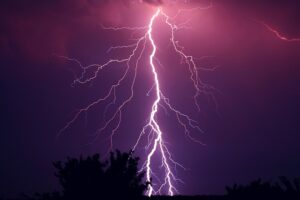As weather patterns become increasingly unpredictable, it is important for individuals to be prepared for natural disasters. One common occurrence that can cause panic and anxiety is a storm. Whether it is a thunderstorm, hurricane or tornado, the intensity of these events can lead to feelings of helplessness and fear.
However, there are steps that one can take to remain calm during a storm. By understanding how storms work and having a plan in place, individuals can minimize their stress levels and stay safe in any situation.
In this article, we will explore some strategies for staying calm during a storm and offer tips on how to prepare yourself for when extreme weather strikes.
Understanding Different Types Of Storms
 As we all know, storms can be both beautiful and dangerous. They come in various forms, each with its unique characteristics and threats to humans and the environment. Understanding these different types of storms is crucial for staying safe during one.
As we all know, storms can be both beautiful and dangerous. They come in various forms, each with its unique characteristics and threats to humans and the environment. Understanding these different types of storms is crucial for staying safe during one.
Tornadoes and hurricanes are two common yet devastating weather events that affect millions worldwide annually. Tornadoes form when warm air meets cold air, resulting in a rotating column of air touching the ground. The wind speeds inside tornadoes range from 65 mph to over 200 mph, causing destruction along their path.
On the other hand, hurricanes are large tropical cyclones that form over warm ocean waters. They have lower wind speeds than tornadoes but cover vast areas as they move across land or sea. Hurricanes cause extensive damage due to their strong winds, heavy rains, storm surges, and flooding.
Thunderstorms and blizzards are also severe weather conditions that people encounter frequently. Thunderstorms occur when moist air rises rapidly into colder regions of the atmosphere, creating thunderclouds that produce lightning strikes, hailstones, high winds, and flash floods.
Blizzards happen mainly in winter when snowfalls accompanied by strong winds create whiteout conditions with low visibility levels making traveling challenging while posing risks of frostbite or hypothermia.
Understanding the difference between these four major types of storms is vital for preparing adequately before one hits your location. Knowing what you’re up against helps reduce panic levels during such situations and enables you to make better decisions about staying safe until it passes away naturally without inflicting any significant harm upon yourself or others around you.
Staying Informed With Weather Updates
Getting weather updates is essential for anyone who wants to stay safe during a storm. Keeping informed about the latest developments in the weather forecast can help you make better decisions and prepare yourself adequately.
There are many ways to get weather updates, such as through television, radio, or internet sources like websites and social media platforms.
Dealing with anxiety during a storm can be challenging, but staying informed can help alleviate some of your concerns. Having accurate information on hand can give you a better understanding of what’s happening outside and enable you to take proactive measures to keep yourself secure.
It’s important not to panic during these times and instead focus on implementing the necessary steps that will ensure your safety.
Staying prepared is an integral part of dealing with severe weather conditions. Ensuring that you have enough food, water, medications, and other essentials stocked up well before any potential storms hit can go a long way toward helping you remain calm and collected when things get rough.
You should also consider having emergency kits readily available at all times in case evacuation becomes necessary.
In summary, keeping updated about changing weather patterns is crucial when it comes to managing natural disasters effectively. Knowing where to find reliable sources of information, remaining calm in stressful situations, and preparing ahead of time are vital components of staying safe during a storm or other adverse weather events.
Remember always to follow the advice given by local authorities and take appropriate actions accordingly.
Creating A Storm Preparedness Plan
One of the most effective ways to stay calm during a storm is to have a preparedness plan in place. This can help you feel more in control and reduce your stress levels.
Your plan should include information on emergency supplies, evacuation routes, and other essential details.
Emergency Supplies: It’s crucial to have an emergency kit stocked with items like non-perishable food, water, batteries, flashlights, first aid kits, and medications. Make sure you maintain these supplies regularly by checking their expiry dates and replacing them as necessary. Additionally, it’s vital to have enough supplies for at least three days.
Evacuation Routes: Familiarize yourself with evacuation routes in your area before a storm hits so that you know where to go if you need to leave your home quickly. Keep maps handy or make use of smartphone apps that offer real-time updates on traffic conditions and road closures.
Other Essential Details: Consider how storms might affect different aspects of your daily life; such as work/school schedules or communication methods available between family members or friends living outside of the affected area. If possible, establish backup plans for transportation arrangements or designate meeting places where everyone can gather safely.
By taking the time to prepare for potential storms beforehand, you’ll be better equipped to handle whatever comes your way when they do occur. Remember always take severe weather alerts seriously and follow any instructions from local authorities immediately without hesitation.
Stay safe!
Finding A Safe Shelter
When it comes to staying calm during a storm, one of the most important steps that you can take is finding a safe shelter.
Before any severe weather event occurs, it’s essential to identify potential risks in your area and have an emergency plan in place. Identifying these risks will help you determine where the safest location for shelter may be.
If there are no designated shelters nearby, consider seeking refuge in a sturdy building or underground structure. Avoid mobile homes or vehicles as they offer little protection against high winds and flying debris.
If you’re unable to leave your home, move to an interior room on the lowest level away from windows and doors.
In addition to identifying safe locations for shelter, having emergency supplies readily available can also make all the difference when facing inclement weather conditions. Some essential items to keep on hand include non-perishable food, water, first aid kit, flashlight with extra batteries, blankets or sleeping bags, and personal hygiene items.
Remember that storms can cause significant damage quickly and unexpectedly. The key to staying calm is being prepared ahead of time by knowing potential risks in your area and having a solid emergency plan in place. By taking these precautions seriously and remaining vigilant during severe weather events, you’ll increase your chances of staying safe throughout the duration of the storm without succumbing to panic or fear.
Practicing Relaxation Techniques
Having found a safe shelter during a storm, the next step to ensure your well-being is to remain calm. Panic and anxiety can lead to poor decision-making, which may put you in danger. As such, it’s essential to learn how to stay calm during a storm.
One way to achieve this is through visualization exercises. Picture yourself in a peaceful environment like a beach or forest while focusing on calming thoughts. This technique helps reduce stress levels by diverting attention from the current situation and providing an escape route for your mind.
Another effective technique that promotes relaxation is deep breathing exercises. During stressful situations, our body tends to take short breaths leading to hyperventilation, which results in further panic.
Deep breathing techniques involve inhaling deeply through the nose and exhaling slowly through the mouth several times until you feel relaxed.
Incorporating these two techniques into your overall response plan can help you maintain composure during storms. It’s also crucial that you practice these techniques regularly so that they become second nature when faced with adverse weather conditions.
Maintaining calmness is vital during emergencies as it enables better judgment and rational decision making about what steps need taking next. By utilizing visualization techniques and practicing deep breathing exercises, individuals are empowered with tools necessary for staying composed amidst turbulence brought about by severe weather patterns.
Focusing On Positive Thoughts
As we weather the storm, it’s important to maintain a calm and positive mindset. One way to do this is through mindfulness exercises. These techniques help us focus on the present moment and acknowledge our thoughts without judgment or attachment. By practicing mindfulness, we can reduce feelings of anxiety and stress that may arise during times of uncertainty.
Another helpful strategy is gratitude journaling. This involves writing down things we are thankful for each day, even amidst challenging circumstances. Research shows that expressing gratitude can improve overall well-being and increase positive emotions. During a storm, taking time to reflect on what we’re grateful for can provide a sense of perspective and hope.
While focusing on positive thoughts won’t make the storm go away, it can help us cope with difficult situations. When we shift our attention from worry to gratitude or mindfulness, we give ourselves space to breathe and process our emotions in a healthy way. Instead of feeling overwhelmed by fear or frustration, we cultivate resilience and inner strength.
In summary, staying calm during a storm requires intentional effort to focus on positive thoughts.
Mindfulness exercises like deep breathing or meditation can help ground us in the present moment while gratitude journaling allows us to appreciate the good things around us despite adversity.
With practice, these strategies can become powerful tools for managing stress and finding peace within ourselves even when external circumstances feel tumultuous.
Seeking Professional Help If Needed
If you find that calming techniques are not enough to help you cope with the stress of a storm, seeking professional help is a viable option. With therapy benefits, mental health awareness has become more prevalent in society today.
Mental health professionals can provide support and guidance for those dealing with anxiety or other related issues during times of severe weather conditions. Here are some ways therapy can benefit individuals during storms:
1. Coping strategies: A therapist will work with you to develop coping mechanisms specific to your needs. These techniques may include breathing exercises, mindfulness practices, and positive self-talk.
2. Emotional support: Talking through fears and emotions surrounding inclement weather events can be helpful in reducing stress levels. Therapists offer an unbiased perspective on how to manage these feelings constructively.
3. Identifying triggers: Therapy sessions can help identify what specifically causes fear or anxiety during storms so that they can be addressed directly.
4. Long-term solutions: Instead of just providing temporary relief, therapists aim to equip their clients with tools that will continue helping them beyond individual appointments.
Mental health awareness is crucial when it comes to managing emotional distress caused by natural disasters like storms. It is important to seek out qualified professionals who specialize in treating anxiety disorders or trauma-related conditions if necessary.
Remember, there is no shame in seeking assistance from others when facing difficult circumstances – everyone deserves access to quality care and support during challenging times such as these.
Frequently Asked Questions
How Do I Prepare My Pets For A Storm?
Pet owners should always have a plan in place to ensure the safety and well-being of their furry companions during natural disasters.
This includes identifying pet shelters or boarding facilities that allow pets, as many human shelters may not be equipped to handle animals.
It is also important to have an evacuation plan specifically for pets, including having a well-stocked emergency kit with food, water, medications, and any necessary documents such as vaccination records.
Additionally, it’s recommended to microchip your pet and make sure they are wearing identification tags at all times in case they become separated from you during the chaos of a storm.
Being prepared ahead of time can help ease some of the stress and uncertainty when dealing with severe weather situations.
What Should I Do If I’m Driving During A Storm?
When driving during a storm, it is important to prioritize safety over reaching your destination. In order to do so, pull over safely and wait until the storm passes or visibility improves.
If it is absolutely necessary to continue driving, make sure to manage visibility by turning on headlights, using windshield wipers and defrosters, and reducing speed accordingly.
It is also essential to have an emergency kit in your vehicle that includes items such as water, non-perishable food, blankets, flashlights with extra batteries, first-aid supplies, and a charged cell phone.
Proper vehicle maintenance before the storm season can prevent breakdowns and ensure safe travel in hazardous conditions.
Remember that staying calm and making thoughtful decisions can ultimately save lives.
Can I Use Candles For Lighting During A Power Outage?
During a power outage, using candles for lighting is a common practice. However, it’s important to follow best practices in order to avoid accidents or fires. Alternatives such as battery-operated lanterns and flashlights are recommended instead of candles due to the potential risks associated with open flames.
If candles must be used, they should always be placed on stable surfaces away from flammable materials and never left unattended. It’s also crucial to keep them out of reach of children and pets. In addition, trimming the wick regularly can prevent excessive smoke and soot buildup that could lead to respiratory problems.
By following these candle safety tips during a power outage, you can minimize hazards and ensure your family’s well-being.
How Can I Protect My Valuables During A Storm?
Water and wind can be both powerful and unpredictable during a storm. It’s important to prepare for the worst by safeguarding your valuables, such as family heirlooms or expensive electronics.
One way to do this is by storing them in waterproof containers that are easy to transport if evacuation becomes necessary. Another crucial step is to have an evacuation plan in place ahead of time so you can focus on getting yourself and your loved ones out of harm’s way instead of worrying about material possessions.
Additionally, make sure your insurance coverage includes protection against natural disasters like storms, and consider having emergency funds set aside specifically for unforeseen events like these. Remember that while it may be difficult to part with sentimental items, their safety should always take a backseat to personal safety during severe weather conditions.
Is It Safe To Use Electronic Devices During A Lightning Storm?
Lightning safety is a crucial concern during thunderstorms, and the use of electronic devices can pose significant electrical hazards. While lightning strikes are relatively rare occurrences, they carry immense amounts of energy that can easily damage electronics or cause injury to individuals in close proximity.
It is recommended that individuals should refrain from using any electronic devices during a storm, including cell phones or computers plugged into outlets. Additionally, it is essential to unplug all appliances and turn off surge protectors as an added precaution against power surges resulting from nearby lightning strikes.
Following these guidelines will help ensure personal safety and prevent potential damage to valuable equipment during a storm.
Conclusion
When faced with a storm, it is important to stay calm and take the necessary precautions.
It is essential to prepare your pets for the storm by keeping them indoors and ensuring they have enough food and water.
If you must drive during a storm, reduce your speed, increase your following distance, and avoid flooded areas.
During a power outage, candles may be used for lighting but caution should be taken as they can pose a fire hazard.
To protect your valuables during a storm, store them in waterproof containers or move them to higher ground if possible.
Finally, it is not safe to use electronic devices during lightning storms as they can attract electrical currents that could cause damage or injury.
Staying calm during a storm is crucial for personal safety and protection of property. Properly preparing yourself, your pets, and your belongings can significantly minimize risk and prevent damages caused by inclement weather conditions.
As meteorologists continue their research on predicting storms more accurately than ever before we are better equipped than ever before to prepare ourselves when bad weather strikes.




